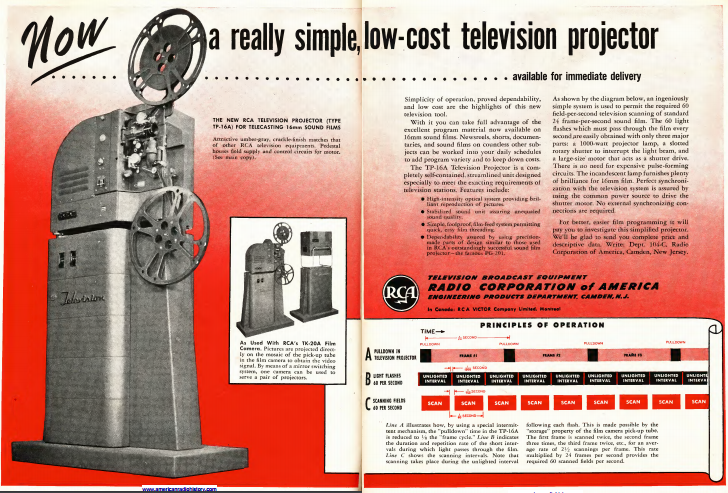This RCA ad from the April 1947 issue of Televiser shows how film was broadcast in the early days of postwar televsision. The prewar stations generally had no way to broadcast prerecorded programming. The ability to use film meant that the television production business was a bit less frenzied, without the need to have some live action going on every moment the station was on the air. Film was still a lot more expensive than the later alternative, video tape, but the ability to use film meant that news and entertainment could be shown on a delayed basis. And since there was no live distribution between most cities, the ability to use film also mean that programs could be shipped to other stations, albeit on a delayed basis.
The RCA TP-16A Television Projector, shown at the left, was a self-contained unit which converted film to video. The unit at the right was a two-piece unit, with the film projector at left and video camera at right. The advantage of the dual unit was that it could be used with two film projectors, a mirror being used to switch from one to the other on the fly.
16mm film was already an established format, but there was one problem that had to be overcome. The 16mm format used 24 frames per second, while the video was 60 frames per second. Synchronization was accomplished according to the diagram at the lower right corner of the ad.
The film fed normally at 24 frames per second. During the first frame, the film was illuminated twice, at 1/60 second intervals, and the frame was scanned twice. The net effect was that half of the film frames were scanned three times, and the others scanned two times, for an average of 2-1/2 video frames per film frame. This resulted in the 24 frame per second film being scanned 60 times per second.
The 1000 watt incandescent bulb lit only about 1/1200 second. The video camera had enough inherent memory that it could complete the scan even though it was unlighted.

